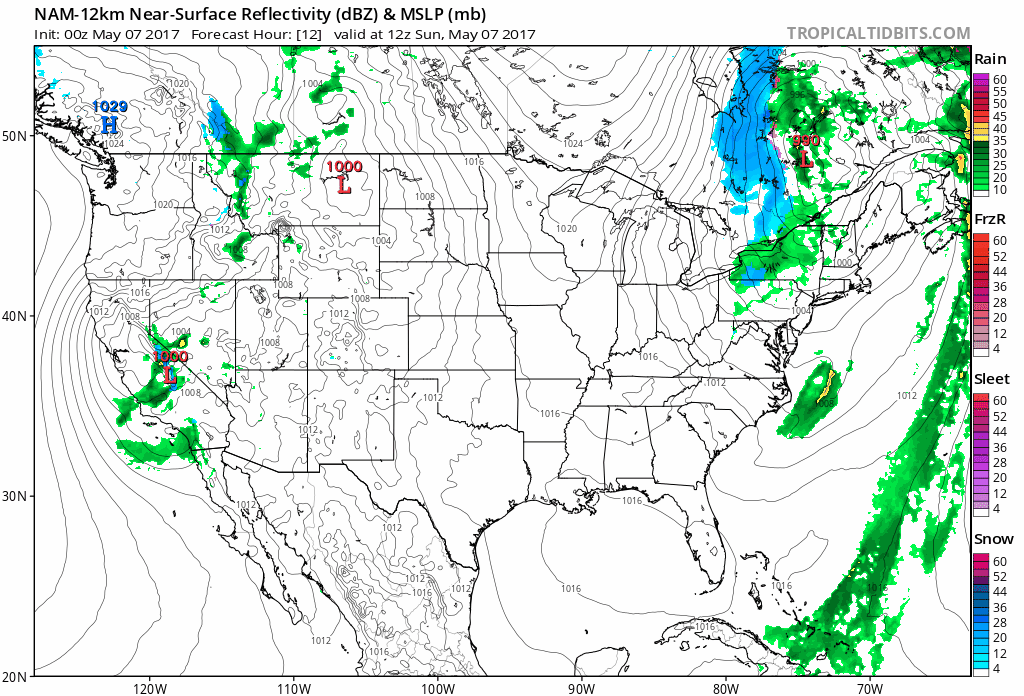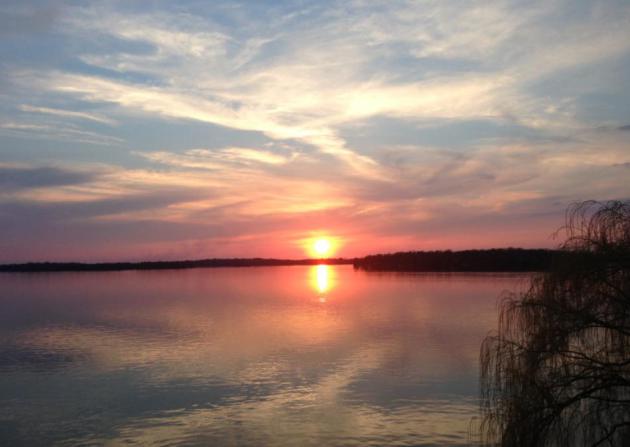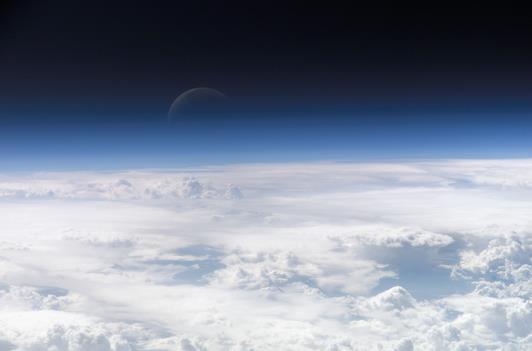67 F. average high on May 6.
92 F. high in the Twin Cities on May 6, 2016.
May 7, 1916: Strong winds sweep across the state and cause dust storms over southern Minnesota. Great damage is done to standing timber in Northern Minnesota. Many fires develop, one of which would destroy 30,000,000 feet of lumber.
Few Complaints in the Weather Department
Behold, Minnesota is enjoying a REAL SPRING this year. That's an atmospheric oddity. So many years we go from ankle-deep slush to complaining about the humidity in a blink of an eye. Easing into summer? What a concept.
Much of Wisconsin is waking up to a frost advisory, a blunt reminder not to plant tender annuals until after Mother's Day. Memorial Day if you want to be absolutely safe.
One silver lining of a winter with 32 inches of snow, when average snowfall is 55 inches? No spring river flooding. Parts of Missouri just experienced a thousand-year flood, probably the 6th billion dollar weather disaster of 2017. Records kept since 1980 show an average of 5.5 separate billion dollar weather disasters every year. Over the last 5 years: 10.5 events/year. Details below.
Plan on mid-60s today; another slice of pure weather perfection. Hard to believe it snowed last Monday. A thundershower may pop up Monday night; otherwise expect dry weather most of next week; lows in the 40s - high temperatures in the 60s.
Garrison Keillor got it right. Minnesotans (and their weather) are usually above average.

Omega Block. The atmospheric holding pattern continues, with showery rains (and snow) for New England and more rain for southern California and Nevada; a ridge of high pressure over the central USA creating dry, sunny, seasonably mild weather. No severe outbreaks in the near term. 84-hour Future Radar: Tropicaltidbits.com.
Cheapest Life Insurance You Can Buy. Time to go on my annual rant, reminding you to invest a whopping $20-40 on a NOAA Weather Radio, if you haven't already done so. Media, apps, sirens are all great, but this is probably the only device that will wake you up at 3 AM if a tornado is heading toward your neighborhood. Get a battery-operated radio, in case power goes out, and make sure it has "SAME" technology, so you can program in your county (and not be needlessly warned for nearby counties). They are worth every penny. Here are a few options available on Amazon.
Housing Quality Plays Role in Tornado Risk. Is it demographics or climate change or a mixture of the two? Here's an excerpt from Realtor Magazine: "...It’s the rising number of mobile homes that has researchers concerned as the threats from tornadoes grow. There are about 9 million mobile homes in the U.S. and an average of about 1,200 tornadoes per year, the most of any country. “If the climatologists are right about the continuing effects of climate change, then people living in mobile homes could be particularly vulnerable to tornadoes in years to come,” says Mark Skidmore, coauthor of the study and an MSU economics professor. In studying tornado fatalities in the U.S. from 1980 to 2014, researchers found that 2,447 tornado-related deaths occurred. The bulk of the deaths occurred in the region of the Midwest and Southeast labeled “tornado alley.” Texas has the most tornadoes annually at 150, followed by Kansas at 80, Oklahoma at 64, and Florida at 61. Florida has the most mobile homes in the nation at 849,304, followed by Texas at 731,652..." (File image: NOAA).
When To Expect Your Last Spring Freeze. Across much of the northern USA it's good to wait to plant annuals until after Mother's Day, give or take. That holds true this year, especially New England. Here's an excerpt from NOAA NCEI: "...Derived from the 1981–2010 U.S. Climate Normals—30-year averages of climatological variables like temperatures—this map shows the time of year, on average, that areas across the nation can expect to see their temperatures dip to 32°F or below for the last time. The map reveals some interesting regional differences across the country. In the East, the last spring freeze date generally progresses through time as you move northward on the map. However, in the West, the changes are much more complex due to elevation and coastal influences..."
Some 400 Soldiers Help with Quebec Floods. A cut-off low, a stalled system dragging Atlantic moisture inland day after day has produced extensive flooding unusually far north. Here's an excerpt from CTV News: "More than 400 soldiers headed to various regions of Quebec on Saturday to help cope with the heavy flooding caused by unrelenting rain in Central and Eastern Canada in recent days. The Canadian Forces personnel were deployed to western and central Quebec and in and around the Montreal area as water levels continued to threaten hundreds of residences. "People are tired psychologically and municipal authorities are running on empty in terms of resources," said Eric Houde, director general of Quebec's civil security services..."
Photo credit: "A resident walks through the flooded streets in the Ile-Mercier district of Ile-Bizard, Que. Friday, May 5,2017." (Ryan Remiorz / THE CANADIAN PRESS).
- "April monthly precipitation totals
varied from near normal in the northwest to one to two inches above
normal in the eastern half of the state. A few locations in east
central, south central and southeast Minnesota reported precipitation
totals that were more than three inches above historical averages.
[see: April 2017 Precipitation Total Map | April 2017 Precipitation Departure Map | April 2017 Climate Summary Table | April 2017 Percent of Normal Precipitation Map] - Average monthly temperatures for April were about one to two degrees above historical averages at most Minnesota reporting stations. The majority of the month was above normal. A sharp cool down for the last five days of the month tugged down the temperature departure a bit. Extremes for April ranged from a high of 83 degrees F near Milan on the 8th, to a low of 12 degrees F at Embarrass on the 11th and 12th..."
Floods May Be 2017's 6th Billion Dollar Disaster. No, it's not your imagination - we're seeing more weather and climate disasters over time. Here's an excerpt from KSGF.com: "...Because of this, flood damages are far from over, and communities up and down the Mississippi could see minor to major flooding in the coming weeks as the excess water works its way to the Gulf of Mexico. All of these damages will continue to add up, and once the tallies are in, they'll likely easily surpass the billion dollar mark, bringing the year's total to six — all before hurricane season. This year is off to a quick start for the number of billion dollar weather disasters, similar to 2016 and 2011, which each had 15 and 16 disasters, respectively. The average number of billion dollar weather disasters in the last five years is 10.6 events. Since records began in 1980, that average number is only 5.5 events..."

Billion Dollar U.S. Weather Disasters. The increase in billion-dollar disasters shows up with severe storms and flooding. Nature never moves in a straight line, but the trends are interesting. Graphic: NOAA NCDC.
Here's Where Heavy Rain Is Increasing the Most. Climate Central takes a look at the trends: "Heavier precipitation is a signature of climate change. For every 1°F of temperature increase, the atmosphere can effectively hold 4 percent more water vapor. So as the world warms from the increase in greenhouse gases, the amount of evaporation also increases from oceans, lakes, rivers, and soils. The extra water vapor is available to produce additional rain and snow, creating an environment ripe for heavy precipitation events which is exactly what we are seeing in the numbers. This week’s analysis, an update from our 2015 Climate Matters, shows an increase in the top 1 percent of daily rainfall events across the vast majority of states in the U.S..."
Dust Storm Chokes Beijing and Northern China. BBC has an update on the thick clouds of dust blowing off the deserts of northern China: "A dust storm is choking a large swathe of northern China including the capital, Beijing, in yet another air quality crisis to affect the country. Official air quality readings have soared well above the recommended World Health Organization (WHO) limit. Authorities are advising residents to avoid outdoor activity and for children and elderly people to remain indoors. The dust is blowing in from neighbouring Mongolia and China's Inner Mongolia Autonomous Region..."
Photo credit: "A work crew for the Pittsburgh company Energy Independent Solutions installs solar panels at a community building in Millvale, Pa." Reid Frazier/The Allegheny Front.
Illustration credit: Michael Paul Young / YouWorkForThem.
The
annual impact of tornadoes is expected to increase threefold over the
next few decades due to the "twin forces of increased climate
variability and growth in the human-built environment," according to the
study, which is published online in the journal Regional Science and
Urban Economics.
"If the climatologists are right about the continuing effects of climate change," said Mark Skidmore, MSU economics professor and co-author of the study, "then people living in mobile homes could be particularly vulnerable to tornadoes in the years to come."
The researchers investigated underlying factors of tornado fatalities in the U.S. from 1980 to 2014. There were 2,447 tornado-related deaths during that period; the bulk occurred in the "tornado alley" region of the Midwest and Southeast.
Read more at: https://phys.org/news/2017-05-climate-tornadoes-mobile-homesa-dangerous.html#jCp
"If the climatologists are right about the continuing effects of climate change," said Mark Skidmore, MSU economics professor and co-author of the study, "then people living in mobile homes could be particularly vulnerable to tornadoes in the years to come."
The researchers investigated underlying factors of tornado fatalities in the U.S. from 1980 to 2014. There were 2,447 tornado-related deaths during that period; the bulk occurred in the "tornado alley" region of the Midwest and Southeast.
Read more at: https://phys.org/news/2017-05-climate-tornadoes-mobile-homesa-dangerous.html#jCp
Photo credit: "Darth Vader Williamson, 39, is a surgical technician at a hospital in suburban Memphis."

TODAY: Sunny. No complaints about the weather. Winds: SE 7-12. High: 65
SUNDAY NIGHT: Partly cloudy. Low: 46
MONDAY: Clouds increase, nighttime thunder? Winds: SE 10-15. High: 66
TUESDAY: Mostly cloudy, isolated shower. Winds: NW 8-13. Wake-up: 53. High: 64
WEDNESDAY: Lingering clouds, showers stay south. Winds: NW 7-12. Wake-up: 47. High: 62
THURSDAY: Partly sunny and pleasant. Winds: N 7-12. Wake-up: 44. High: 64
FRIDAY: Intervals of sun, risk of a shower. Winds: NW 5-10. Wake-up: 48. High: 67
SATURDAY: Mostly cloudy, cooler breeze. Winds: NE 10-15. Wake-up: 46. High: 62
Climate Stories...
Extreme Weather Flooding the Midwest Looks a Lot Like Climate Change. Warmer air holds more water vapor. Full stop. Here's an explainer at InsideClimate News: "...Parts of Missouri, Illinois, Indiana, Arkansas and Louisiana received 10 to 15 inches of rain in the past seven days, according to the National Weather Service, resulting in record crests of numerous rivers across the central United States. Extreme storms like these have become more common as global temperatures have risen and the oceans have warmed. Some have the clear fingerprints of man-made climate change. "Of course there is a climate change connection, because the oceans and sea surface temperatures are higher now because of climate change, and in general that adds 5 to 10 percent to the precipitation," Kevin Trenberth, a climate scientist with the National Center for Atmospheric Research, said. "There have been many so-called 500-year floods along the Mississippi about every five to 10 years since 1993..."


Is Climate Changing Cloud Heights? Too Soon To Say. Clouds have a cooling effect, but it's unclear how a warmer atmosphere will impact cloud formation. Here's an excerpt from NASA: "...A new analysis of 15 years of NASA satellite cloud measurements finds that clouds worldwide show no definitive trend during this period toward decreasing or increasing in height. The new study updates an earlier analysis of the first 10 years of the same data that suggested cloud heights might be getting lower. Clouds are both Earth's cooling sunshade and its insulating blanket. Currently their cooling effect prevails globally. But as Earth warms, the characteristics of clouds over different global regions — their thickness, brightness and height — are expected to change in ways that scientists don't fully understand. These changes could either amplify warming or slow it. Pinning down some of the uncertainties around clouds is one of the biggest challenges in determining the future rate of global climate change..."
Photo credit: "Climate change may eventually change global cloud heights, but scientists need a longer data set to know whether that's happening already." Credit: NASA.

How to Make a Carbon Tax Insanely Popular. A story at The Week offers up one way to make a carbon tax fair for the poor and disadvantaged: "...So
what to take from this? Coalitions created across the traditional
liberal-conservative or Democrat-Republican divides will be in trouble.
Right-wing supporters will push towards offsetting the carbon tax with
other tax reductions, or elimination of regulations. Baker and the other
Republicans pushing the carbon tax, for instance, would like it to
replace Obama-era climate regulations. But to be broadly popular, a
carbon tax simply cannot be divorced from a broader left-populist
economic agenda. To succeed politically, it will need to come in a
broader package of policies, the net effect of which leaves most
Americans better off. As Paul argued: "The environment is something
that, when we're born, each and every one of us has a common piece of
ownership. And a tax and dividend policy restores that notion of common
ownership."

- Replacing fluorocarbons used in refrigeration and air conditioning equipment with atmospherically benign alternatives like propane and ammonium.
- More electric generation from onshore wind turbines.
- Reducing food waste by one-half worldwide.
- Shifting more of the global diet from meat to plants.
- Restoring tropical forest on about half the degraded acreage identified as plausible reforestation locales.
- Assuring 13 years of schooling for girls around the world, especially in the poorest countries, as the surest path to voluntary population control.
- Encouraging family planning, with enhanced access to contraception, as a corollary effort.
- More utility-scale “solar farms...”
Map credit: "This map shows five of the 17 communities in the U.S. that are in the process of climate relocation. Upwards of 13 million Americans will be at risk of displacement from a projected 0.9 m rise in sea levels by 2100." (Center for Progressive Reform).
Global Warming "Hiatus" is Debunked Again by Researchers. Pause? What pause? Here's an excerpt from InsideClimate News: "...A new analysis in the journal Nature took a comprehensive look at what had been published on both sides of the issue. It found that a number of inconsistencies among studies proposing a hiatus—including variations in how the term "hiatus" was defined—led to cascading confusion. The study also pointed to some lessons for communicating climate science in the future. "It is easy to paint a controversial picture, but as often the devil is in the details," wrote the authors, who are scientists at the Institute for Atmospheric and Climate Science at ETH Zurich in Switzerland..."

File image: NASA ISS.

No comments:
Post a Comment